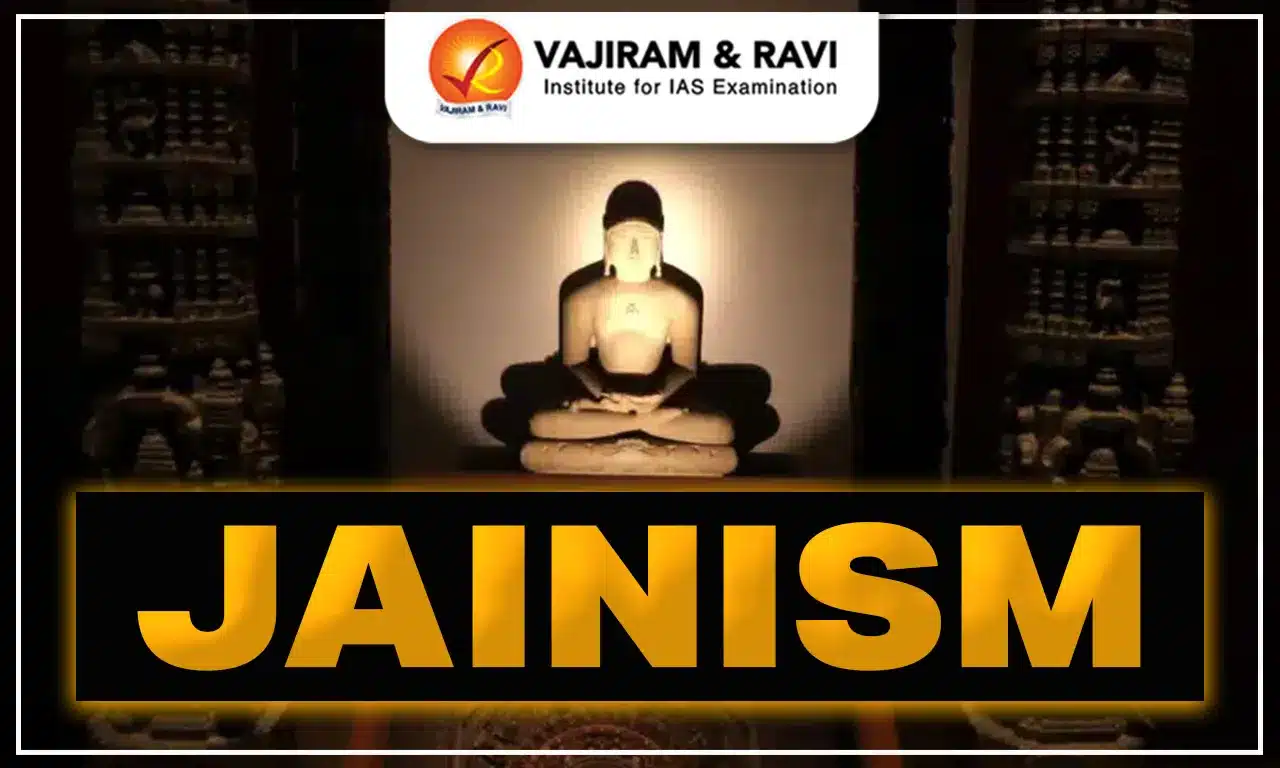In the sixth century BC, Jainism emerged as a result of widespread opposition to the formalized ritualism and hierarchical structure of the Vedic religion. Jainism is one of the religions whose origin can be traced back to the twenty four teachers (tirthankaras - ones who establishes a path or ford), through whom their faith is believed to have been handed down.
Jainism is a sramanic religion. Sramana' is a Sanskrit word that denotes an ascetic or monk. The practice of virtues such as non-violence, renunciation, celibacy, self-control, etc., as well as asceticism, mysticism, meditation, contemplation, silence, and solitude, among others, are distinguishing features of this tradition.
Factors led to the Rise of Jainism in India
The primary cause of the rise of religion was the religious unrest in India in the 6th century BC. Other major factors include:
- Complex religious practices: In the later Vedic period, Indian society had many complex rituals and sacrifices that were unacceptable to the common people.
- For example, the sacrificial ceremonies were too expensive, and the superstitious beliefs and mantras confused people.
- Domination of Brahmans: The Brahmans stated themselves as upper Varna with the highest status in society and demanded several privileges. Thus, these systems naturally divided society and generated tensions.
- Opposition from Kshatriyas and Vaishyas: They reacted strongly against the ritualistic domination of the Brahmans.
- The equality of Jainism: Attracted the masses, which gave relief from the discriminations of the Varna system.
- Use of Simple Language: Mahavira’s religious message was in simple language. The masses were drawn to it because it was in the language they spoke and understood better. Acceptance by the masses soon led to its spread.
- Simple Doctrine: Vardhaman Mahavira’s Jainism came to the masses as a welcome relief.
- Nonviolence and other practical moralities that Jainism advocated attracted people to it.
- Its edge over the Vedic religion was a comparatively easier way to liberation, thereby gaining wider adherence throughout India.
Historical Background of Jainism
According to Jaina traditions, twenty-four Tirthankaras were responsible for the origin and development of Jaina religion and philosophy. Of these, the first twenty-two are of doubtful historicity. In the case of the last two, Parsvanatha and Mahavira, Buddhist works confirm their historicity.
- Adinath/Rishabhdev: The first Tirthankara (supreme preacher) and establisher of the Ikshvaku dynasty.
- Ajita: The second Tirthankara
- Neminatha: the twenty-second Tirthankara
- Parsvanatha: According to Jaina tradition, the twenty-third Tirthankara, Parsvanatha, was the son of King Asvasena of Varanasi and Queen Vama.
- Parsvanatha believed in the eternity of ‘matter’.
- The followers of Parsvanatha wore white garments.
- Thus, it is clear that even before Mahavira, some kind of Jaina faith existed.
- Mahavira: The twenty-fourth Tirthankara was Vardhamana Mahavira.
Read more about: Mahavir Jayanti 2025
Mahavira and his life
The 24th Tirthankara was Vardhamana Mahavira.
- Birth: Born in Kundagrama (Basukunda), a suburb of Vaishali (Bihar), in 540 BC.
- Parents: Father Siddhartha (head of the Jnatrikas, a Kshatriya clan) and mother, Trishala, a Lichchavi princess.
- Spouse: Yashoda
- What made Vardhaman Mahavira take up asceticism?
- At the age of thirty, Vardhamana left his home and became an ascetic.
- For twelve years, he lived the life of an ascetic following severe austerities.
- In the 13th year of his asceticism, at the age of 42, he attained the ‘Supreme Knowledge’ (Kaivalya).
- Titles: He was later known as ‘Mahavira’ (the supreme hero) or ‘Jina’ (the conqueror). He was also hailed as ‘Nirgrantha’.
- Preachings: For the next thirty years, he moved from place to place and preached his doctrines in Kosala, Magadha, and further east.
- Patronage: He often visited the courts of Bimbisara and Ajatasatru.
- Death: He died at Pawa (near Rajagriha) in Patna district at the age of 72 (468 BC).
Jain Councils
| First Jain Council (300 BC) | Second Jain Council (512 AD) | |
| Venue | - Pataliputra (Bihar) | - Vallabhi (Gujarat) |
| Presided by | - Sthulbhadra | - Devardhigani Kshemasarmana. |
| Patronage | - Chandragupta Maurya | -NA- |
| Outcome | - Sthulabhadra divided the Jaina canon into 12 ‘angas’ or sections, and they were compiled. | - New additions were made in the form of "upangas" or minor sections. |
Teachings of Mahavira
The ultimate objective of Mahavira’s teachings is how one can attain total freedom from the cycle of birth, life, pain, misery, and death and achieve the permanent blissful state of one's self. This is also known as liberation, Nirvana, absolute freedom, or Moksha.
Pancha Mahavratas in Jainism
Mahavira accepted most of the religious doctrines laid down by Parsvanatha. However, he made some alterations and additions to them. The five doctrines of Jainism (five vows), known as Panchamahavratas, are for the monks.
| 4 doctrines advocated by Parsvanath | 5th Doctrine added by Mahavira |
|
|
- Anuvratas: A code of conduct was prescribed for both householders and monks. To avoid evil karma, a householder had to observe the five vows (in their limited nature).
- Jainism believed that the monastic life was essential to attaining salvation, and a householder could not attain it.
- A monk had to observe certain strict rules and abandon worldly possessions.
- The idea of soul and matter: Mahavira believed that soul (jiva) and matter (ajiva) were the two basic existing elements.
- According to him, the soul is in a state of bondage created by desire accumulated through previous births.
- The liberated soul then becomes ‘the pure soul." He thought that all objects, animate and inanimate, had a soul.
- He believed that they felt pain or the influence of injury.
- The idea of Moksha: According to Jainism, man is the creator of his own destiny, and he could attain ‘moksha’ by pursuing a life of purity, virtue, and renunciation.
- He advocated a life of severe asceticism and extreme penance to attain ‘nirvana’ or the highest spiritual state.
| Ratnatraya/three jewels (three principles required to be observed to attain Moksha/Nirvana) | ||
| Samyak Darshan: Right belief | Samyak Gyan: Right knowledge | Samyak Charitra: Right action |
- The idea of God: He believed that the world was not created by any supreme creator. The world functions according to an eternal law of decay and development.
- View on Vedas: He rejected the authority of the Vedas and objected to Vedic rituals and the supremacy of the Brahmanas.
8 Auspicious Symbols of Jainism
Jainism has several important symbols that hold significant meaning for its followers. Here are some of the key symbols of Jainism:
- Swastika - It signifies the peace and well-being of humans.
- Nandavarta - It is a large swastika with nine endpoints.
- Bhadrasana - A throne is said to be sanctified by the Jaina’s feet.
- Shrivatsa - A mark manifests on the chest of Tirthankara's image and signifies his pure soul.
- Darpana - The mirror which reflects the inner self.
- Minayugala - A couple fish which signifies the conquest over sexual urges.
- Vardhamanaka - A shallow dish is used as a lamp, which shows the increase in wealth, due, and merit.
- Kalasha - A pot filled with pure water.
Five types of knowledge in Jainism
According to Jainism, knowledge is the quality of the soul. Understanding and acquiring knowledge are attained through pramana (instruments of knowledge) and naya (points of view).
- Mati Jnana: Perception through the activity of sense organs, including the mind.
- Sruta Jnana: Knowledge revealed by the scriptures.
- Avadhi Jnana: Clairvoyant perception.
- Manahparyaya Jnana: Telepathic knowledge
- Kevala Jnana: Temporal knowledge or omniscience.
Mahavira’s teachings were orally transmitted to people. His disciples, Ganadharas, wrote them down in the text form of fourteen ‘Purvas’ and twelve Angas.
Among the 12 Angas, the Acharanga sutta and Bhagavati sutta are the most important. While the former deals with the code of conduct which a Jain monk must follow, the latter expounds the Jaina doctrines comprehensively.
Doctrine of Syadvada and Anekantavada
- Syadvada (Theory of Judgement): The Jain view that all our ordinary knowledge is necessarily partial, always relative to some particular point of view and particular aspects of objects, is known as Syadvada.
- According to this concept, identity and difference must exist in reality.
- Anekantavada: According to this doctrine, ultimate truth and reality is complex and has multiple aspects.
- Anekantavada has also been interpreted to mean- non-absolutism, intellectual ahimsa, religious pluralism, and rejection of fanaticism.
Sects of Jainism
The Jain order has been divided into two major sects: Svetambara and Digambara.
- Reason for division: The division occurred mainly due to famine in Magadh, which compelled a group led by Bhadrabahu and Chandragupta Maurya to move to South India (Shravan Belgola) in 298 BC.
- The leader of the group that stayed back at Magadha wasof Sthulbhadra.
- During the 12 years of famine, the group in South India stuck to the strict practices, while the group in Magadha adopted a more lax attitude and started wearing white clothes.
- During later years, further splits took place among both sections, the most important of them being one that renounced idol worship altogether and devoted itself to worshipping the scriptures.
- They were called the Terapanthis among the Svetambaras and the Samaiyas among the Digambaras. (This sect came into existence about the sixth century CE).
| Sects | Digambaras | Svetambaras |
| Led by | Bhadrabahu | Sthulbhadra |
| View on Clothing |
- They do not wear clothes, as this sect believes in complete nudity. - Female monks wear unstitched, plain white sarees and are called Aryikas. |
- They wear simple white clothes. |
| Question on women | - They believed that women could not be Tirthankaras and Malli was a man. | - They believe that Tirthankaras can be men or women. |
| Follow the teachings of | - Mahavira, that is, “Pancha Mahavratas”, to attain Kaivalya. | - Preachings of Parshvanatha, that is, only four restraints (except Brahmacharya). |
| Follow the Jain literature | - Prakrit Suttapahuda of Kundakunda. | - Believed in the validity and sacredness of the twelve angas and sutras. |
| Food for omniscient | - Once a saint becomes a kevalior Kevala-jnani,that is, omniscient, he needs no morsel of food. | - This view is not acceptable to the Svetambaras. |
| Idols of Tirthankaras | - They represent the idols of Tirthankaras as nude. Unadorned and with downcast eyes in a contemplative mood. | - Depicts the idols of Tirthankars as wearing a loin-cloth adorned with jewels and with glass eyes inserted in the marble. |
Sub-sects of Jainism under Digambaras and Svetambaras
| Digambaras | Svetambaras |
|
- Mula Sangh:
- Bisapantha:
- Digambar Terapantha:
- Taranpantha:
|
- Sthanakavasi:
- Murtipujaka (Deravasi):
- Terapanthi:
|
Spread of Jainism to other parts of India
Jainism spread to different parts of India during Mahavira's lifetime and after his death. Several factors are responsible for its spread.
- Contribution of Mahavira: Mahavira moved from place to place and preached his teachings.
- His simple way of life, penance and austerity attracted people towards him.
- Mahavira had eleven disciples known as Ganadharas or heads of schools.
- Arya Sudharma was the only Ganadhara who survived after the death of Mahavira. Mahavira became the first ‘Thera’ (chief preceptor).
- Role of Jain Monks: Jain monks spread Jainism by visiting several places and holding scholarly discussions exhibiting their personal examples of simplicity, which could significantly influence the people.
- Royal Patronage: The followers of Mahavira slowly spread over the whole country. In many regions, royal patronage was bestowed on Jainism.
- According to Jaina tradition, Udayin, the successor of Ajatasatru, was a devoted Jaina.
- Chandragupta Maurya was a follower of Jainism, and he migrated with Bhadrabahu to the south and spread Jainism.
- During the early centuries of the Christian Era, Mathura and Ujjain became great centres of Jainism.
- Two Theras administered the Jaina order in the days of the late Nanda King: Sambhutavijaya and Bhadrabahu. The sixth Thera was Bhadrabahu, a contemporary of Maurya King Chandragupta Maurya.
Relevance of Jain Ideology in today's World
The doctrines of Jainism with respect to the contemporary world situation are found to be very much relevant. With these doctrines of Jainism, we can bring back the peace and harmony in the society and the world.
- Anektavada highlights the spirit of intellectual and social tolerance in the world.
- Non-violence: The principle of non-violence gained prominence in today's nuclear-weapon world to attain long-lasting peace in society.
- The principle of Aparigraha can help to control consumerist habits as there is a great increase in greed and possessive tendencies.
- The doctrine of Triratna is relevant to present-time situations, which can liberate the souls of women along with men from the subjugation to liberty and freedom.
Last updated on December, 2025
→ Check out the latest UPSC Syllabus 2026 here.
→ Join Vajiram & Ravi’s Interview Guidance Programme for expert help to crack your final UPSC stage.
→ UPSC Mains Result 2025 is now out.
→ UPSC Notification 2026 is scheduled to be released on January 14, 2026.
→ UPSC Calendar 2026 is released on 15th May, 2025.
→ UPSC Prelims 2026 will be conducted on 24th May, 2026 & UPSC Mains 2026 will be conducted on 21st August 2026.
→ The UPSC Selection Process is of 3 stages-Prelims, Mains and Interview.
→ UPSC Result 2024 is released with latest UPSC Marksheet 2024. Check Now!
→ UPSC Toppers List 2024 is released now. Shakti Dubey is UPSC AIR 1 2024 Topper.
→ Also check Best IAS Coaching in Delhi
Jainism FAQs
Q1. What is Jainism?+
Q2. What are the five vows of Jainism?+
Q3. What are the three Ratnas of Jainism?+
Q4. What is the ideology of Jainism?+
Q5. Who are the Tirthankaras?+


















